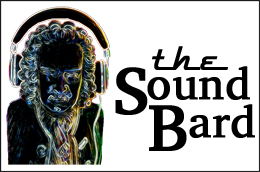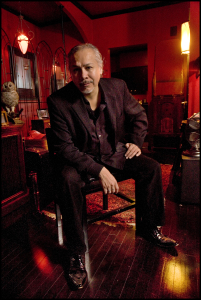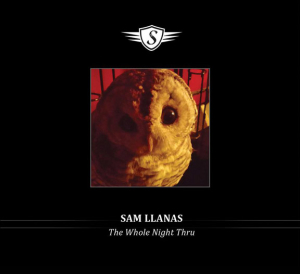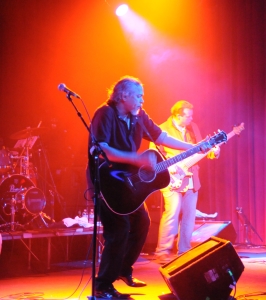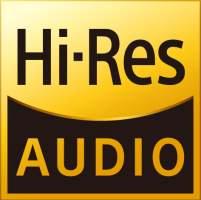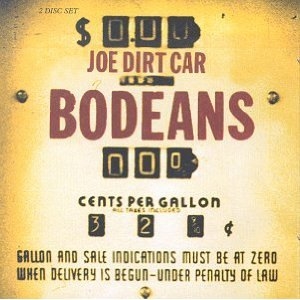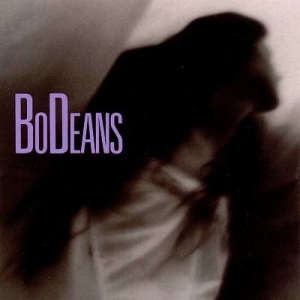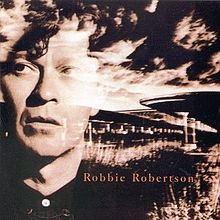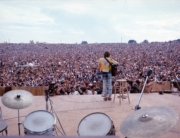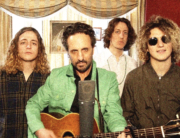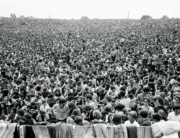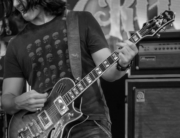BY MIKE METTLER — JANUARY 28, 2015
“I’ve always been a fan of records that tastefully use effects to enhance the listening experience,” says Sam Llanas, former vocalist/guitarist for roots-rock pioneers BoDeans, now ensconced in a full-time solo career. Llanas’ distinct vocal tone — which resides somewhere between gravel and grace — has touched the soul of indelible songs like “Closer to Free,” “Feed the Fire,” and “Rickshaw Riding,” and on The Whole Night Thru (Llanas Music), Llanas opens up his palette on deeply personal tracks like “Deja Vu” and “I’m Still Alive” to achieve an even more honest aural identity. “We did decide early on that we would like to make a record that would be engaging on headphones,” he reports.
Here, Llanas, 53, and I — along with producer Gary Tanin and engineer Ric Probst — discuss the importance of equipment choices and microphone placement, how to make a record that hits “hard and fast,” and his favorite BoDeans album. The man is very much still alive and kicking.
Mike Mettler: I’m sure capturing the very specific, unique character of your voice — as on tracks like “Deja Vu,” “Dangerous Love,” and “Addicted to the Cure” — well, on all of the album, really — is of paramount importance to you in the studio. Do you take a hands-on approach to things like microphone choice and microphone placement? What equipment do you prefer to use in the studio environment?
Sam Llanas: Mike, I’m not a technophile at all! Something either sounds good to me, or it doesn’t. I’m much more interested in capturing a great performance than anything else. I do realize, however, that choosing the right microphones, EQs, etc., is very important if you want a great-sounding record. I leave those choices to my producer Gary Tanin and engineer Ric Probst.
Gary Tanin: All the vocals and acoustic guitar overdubs, and some percussion and keyboard overdubs, were recorded at my studio [Daystorm Music, in Milwaukee]. I used a custom-modded Telefunken M16 clone that I’ve used on Sam’s vocals for all of The Whole Night Thru. It uses a Westinghouse (UK) 12AX7 that was hand-selected for tonal quality. I’ve been used to recording Sam on the BoDeans’ vintage AKG C24, and wanted to use a mic with similar character. Acoustic guitar was captured with a pair of vintage Sony ECM-33F in an XY pattern. On some of Sam’s ethereal-sounding vocals, I had the M16 clone in a corner of the overdub room in OMNI mode. Percussion overdubs were done in my “Live” room, which has a cathedral ceiling and reflective walls. Ryan [Schiedermayer]’s old Civil War drum was captured there. You can hear that as almost like thunder on the track “Somethin’ Comin’.”
Ric Probst: Well, Gary and I try to do as many projects together as possible. We feed off of each other’s approaches to recording. Although both of us are long-time engineers, each with decades-long careers, Gary’s role in this project was that of producer. When he asked if I’d like to be part of the project, I jumped at the chance. We certainly faced some unique challenges, as this was a remote-tracking situation, but all involved were pleased with the results. Gary and I are especially honored with the record reviews, which have been overwhelmingly positive.
The microphone selection for the tracking dates was fairly traditional, going with tools that have been proven over and over again. The drum mics were Beyer M-88 (kick), Shure SM 57 (snare top), Shure SM 57 (snare bottom), ’80s vintage Sennheiser 421s (all toms), AKG vintage 414 EBs (CK 12 capsules; overheads), and Neumann KM 184 (hi-hat).
The bass was all DI and two bass rigs — Ashdown Evo II (head) and Ashdown 2×12. The bass cabinets were miked with Sennheiser 421s. All guitar cabinets/amps were miked with Cascade Fathead IIs with Lundhal transformers. I love these picks for guitar!
Finally, the mic pre’s were a combination of a Grace 801 and a Focusrite 828. The platform was Pro Tools 9. There was no processing done during the tracking process.
Mettler: Excellent. To me, gear choice and mic placement — especially when it comes to the snare — is paramount in getting the sound you want the listeners to hear. Sam, you often employ echo/reverb as an effect on your vocals, which I also happen to like very much. Do you have a particular blueprint for how your vocals should be recorded and how you want us, the listeners, to hear them?
Llanas: Like l said, I usually like to get a good vocal take recorded first, and then I will decide from there what kind of and how much of an effect or effects to use. It’s usually a trial-and-error process, although I do have to say that we did decide early on that we would like to make a record that would be engaging on headphones. I’ve always been a fan of records that tastefully use effects to enhance the listening experience.
Mettler: Oh, me too. Many of these songs, like “Everywhere But Here,” feature lead-guitar work that’s clear and upfront in the mix, which I think lends added muscle to your message. What were the overall production goals you and Gary discussed for this album?
Llanas: We wanted to make a record that hit hard and fast. That’s why there’s only nine cuts on the record, and that’s why the cuts are all relatively short. We tried to trim the songs of all unnecessary fat. Consequently, when Sean Williamson’s guitar leads hit, they have maximum effect. It seems that, these days, people don’t take the time to listen to an album in its entirety. We tried to do all we could to encourage that they might.
Tanin: I’ve been fortunate in having produced all of Sam’s solo records, which gave me clarity and insight into the artist’s approach to recording, vocal styling, and vision. I knew this record was to be a departure from Sam’s previous solo records and had to reflect his legacy in a modern context. That meant layers of vocal harmonies (a la BoDeans), emotional deliveries, and a guitar-driven sound with tasteful use of effects to keep the journey engaging and a bit unpredictable. I’m very proud of the results we’ve achieved on all our records together; each one is unique and unlike the previous one. This album is the pinnacle of the three studio album trilogy — A Good Day to Die (1998, under the band name Absinthe), 4.A.M. (The Way Home) (2011), and The Whole Night Thru (2014).
Mettler: What is your guitar, or guitars, of choice these days? Is there a particular sound you’re striving for as an acoustic guitar player?
Llanas: I don’t consider myself to be a real guitar player, but having said that, l have come up with a couple of picking techniques and a tapping approach that can be quite effective. On the record, there is very little of my rhythm acoustic guitar featured, but if you were to strip away the other instruments, you would hear my Taylor being strummed thru a Crate acoustic amp that we tracked live. On the songs “I’m Still Alive” and “To Where You Go,” I play another Taylor that we close-miked. I like to hear the full spectrum of the acoustic guitar. I call it hearing the wood! It’s not that easy to achieve in a rock-band setting, but that was the goal. I’ve been playing Taylor guitars for quite awhile now, and I also have a Takamine that sounds fat and full when you plug it in. I use a pretty little blonde Guild as my main writing guitar.
Mettler: Who would you consider your influences on guitar?
Llanas: I’ve always been a fan of sparse, tasteful players, because to me, a few notes played the right way can be way more effective than someone playing theatrically just to show they can. Some of my favorite players include David Gilmour, Prince, JJ Cale, Willie Nelson, Keith Richards, T Bone Burnett, and Mike Campbell.
Mettler: “I’m Still Alive” is one of the most poignant songs on the album to me, given the subject matter, the inherent emotionality in your vocals, and the sound of the acoustic guitars and the drums. Can you break down the writing/production/sonic choices for that song?
Llanas: “I’m Still Alive” was the last song written and the only song not tracked live for the album. It was written on January 1, 2014, and recorded probably in late February or March. The other songs were recorded in my living room in April 2013, l think. I spent a good deal of time in New Orleans over the years and lost several prized possessions, including my whole vinyl collection, in Hurricane Katrina, so I think the sense of loss is coming from a true place in the song.
We recorded it in Gary’s overdub room at his mastering studio — which has solid 3/4-inch knotty-pine paneling. We also recorded all the vocals there too. We started with just my guitar and vocal. This was a first-take vocal with guitar. l asked Gary to try a piano arrangement on the piece. He also added mellotron flutes and created string arrangements for the track. Sean Williamson recorded an atmospheric pedal-steel part that we used way in the distance. It all seemed to enhance the song without taking away from its intimate nature.
Tanin: The most unique song on the record started out as a demo recorded a few days into the new year (2014). “I’m Still Alive” was a natural for treatment with piano and strings. There was an homage to The Beatles’ “Strawberry Fields Forever” with the mellotron flutes. There was no percussion other than the tapping technique Sam used on guitar, so his meter drove the rest of the song. It truly was the first vocal takes we recorded that made the final mix. That just couldn’t be topped — and we did try to top that first performance. Sam and I rarely disagree on final vocal takes, as they tend to be obvious — at least to us.
Mettler: I also love how “I’m Still Alive” is immediately followed by the grit of “Somethin’ Comin’ ” — and I so love Sean’s smoky slide guitar there too! Is sequencing still important to you as an artist? Do you feel people should listen to an album all the way through, just as you intended, rather than randomly sampling tracks?
Llanas: Yes, I sequenced the record, and yes, it is still important to me. Unfortunately, these days, it seems mostly an exercise in futility, but I want to believe that there are still some people out there who prefer to take the musical journey that the artist visualized.
Mettler: Do you have a preferred way of listening to music yourself these days? Are you a fan of vinyl? Could we expect to get The Whole Night Thru on vinyl at some point?
Llanas: I love to hear vinyl when I can, and I still think it is a superior listening experience, but I know that technology is not going back — although I do applaud the people who are keeping vinyl alive! Unfortunately, vinyl has become very expensive to manufacture, so I cant afford to do that right now, but I would love to hear my record in that format. I really miss hearing the music in fine studios off the 2-inch tape! Now that is the ultimate!
Mettler: I very much agree, as both you and I know what gets lost with the MP3 format in terms of what you want us to hear after approving the final masters. Personally, I feel high-resolution audio is the best way to hear music like yours in the digital realm. All of the vocal subtleties, separation of instruments, and production qualities are right there, and nothing is lost. We get to hear it exactly how you intended. Services like HDtracks, Acoustic Sounds Super HiRez, and Neil Young’s Pono are all doing a great job in delivering the highest quality music files, in my opinion.
Llanas: Yes, to me MP3s sound so thin that they’re hard to listen to. I’m really looking forward to when high-res audio becomes a standard format. Go Neil!
Mettler: You’ve said that you view The Whole Night Thru as your first “official” solo record. Is it liberating to define yourself as a solo artist at this point in your career?
Llanas: I view this new record as my first real solo release because it’s the first one I’ve made without having to be careful of treading on BoDeans territory, so to speak. I don’t know if it’s liberating to define myself that way, but I certainly wanted to liberate myself from a situation where my ex-partner viewed himself as the sole creator of the music and gave me little to no credit.
Mettler: With the BoDeans in the rearview mirror, would you mind encapsulating what you consider that band’s finest moments/accomplishments? Do you have a particular personal favorite song/album from that catalog?
Llanas: The finest moments of the BoDeans were always onstage. Live, the songs were driven mainly by two voices and very simple instrumentation, allowing the vocals to be heard in a very pure way. l think we rarely captured that in a studio. Joe Dirt Car (1995) is the best representation of this, in my opinion. Having said that, I would even venture to say that the BoDeans might have been at their best before we ever had a bass player, with Guy Hoffmann on drums. That was in our freshest and most unique form.
Mettler: Obviously, many people consider the BoDeans’ debut album, Love & Hope & Sex & Dreams (1986), to be a benchmark in terms of its approach, freshness, songwriting prowess, and overall sound. I know T Bone Burnett remains fond of it to this day. What’s your take on it now, almost 30 years down the line?
Llanas: I know why most fans love that record, but like a lot of artists, l mostly hear what I feel is wrong with it and things I wish I could change about it — mostly in the sound of my voice! But T Bone did do a fine job of helping us capture a raw, fresh feeling and in helping us make the best record we were capable of making at that moment in time.
Mettler: If you don’t mind going even further back into the Wayback Machine for a moment, can you tell me what the first record you bought with your own money was, and what kind of impact it may have had on you as both listener and performer?
Llanas: I never had much money to buy records when I was a kid, but I do remember a record I bought called “Morning Girl,” by the The Neon Philharmonic (1969). I don’t know what effect it had on me other than I liked it. Pop AM radio from the mid-’60s through the early-’70s had the biggest effect on me, especially as a writer. It was a virtual songwriting master class.
Mettler: Ah, good ol’ radio. I spoke with Robbie Robertson back in 2013, and he fondly recalled working with you on his first solo album in 1987. What do you remember about working with Robbie? Are you pleased with how your work turned out on tracks like “Somewhere Down the Crazy River”?
Llanas: Working with Robbie was a real gift for a young musician because I also got a chance to work with the great producer Daniel Lanois and a young Jim Scott, who would go on to become a fine producer as well. Talk about a master class!
Obviously, it was a bit intimidating, but when you work with the best people, it tends to bring out the best in you. I loved “Crazy River” from the start, but was a little puzzled that my voice was left so dry and unaffected on a track that just drips with such sonic atmosphere. But I get it now.
Watch Robbie Robertson’s “Somewhere Down the Crazy River” video, directed by Martin Scorsese
Mettler: Would you work with Robbie again?
Llanas: Of course I’d work with him again. I’ve been waiting for the call! I think he may be the finest American songwriter that wasn’t born in America.
Mettler: True — he captures the feel of America so well, just like another non-American, Mark Knopfler, does. Do you have any other dream collaborators?
Llanas: Dream collaborators? Far too many. I’ve always been a fan of people who go their own way. Roy Orbison, Bob Dylan, Joni Mitchell, The Clash, Tom Waits, and more recently, My Morning Jacket and Kings of Leon. And I’m very interested to hear where Lorde is headed. I’d sing with any of them anytime.
Mettler: Now that you have this album under your belt, can we expect another one anytime soon, and if so, what might it sound like? No pressure or anything like that…
Llanas: I’d like to make another record ASAP. Financing will be the biggest obstacle. I think I have the songs ready. Now that I’ve finished the trilogy of “night music,” l think I would like the next one to be much more lighthearted.
